Climate-Resilient and Sustainable Soil Remediation: Hydrocycloning for Metal Removal in Flood-Prone Brazilian Region
Abstract
1. Introduction
2. Materials and Methods
2.1. Materials
2.1.1. Characterization of the Study Area
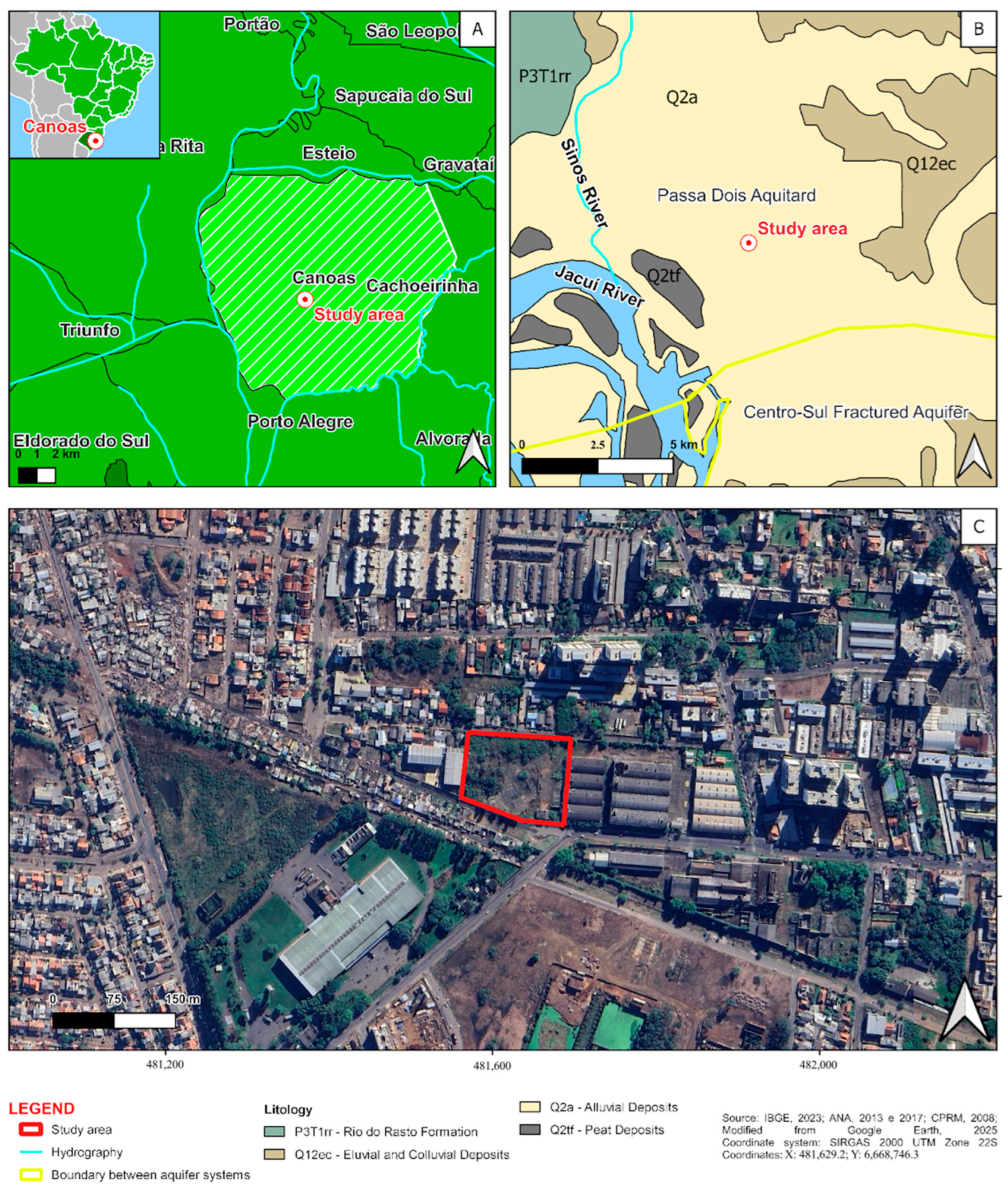
2.1.2. Environmental Characterization
2.1.3. Flood Susceptibility of the Region: The Case of Rio Grande Do Sul in 2024
2.2. Methods
2.2.1. Selection of Remediation Techniques
2.2.2. Soil Washing System Using Hydrocycloning
- Double-stage hydrocycloning: The contaminated soil is washed and subjected to successive cycles of particle size separation to isolate finer particles.
- Coagulation in a conical tank: The liquid fraction containing fine particles (clay and silt) is directed to a tank, where a chemical coagulant (anionic polymer) is added to promote the aggregation of contaminants into flocs.
- Sedimentation: The coagulated mixture (water + fine particles + coagulant) is transferred to a conical bottom settling tank, where the flocs are allowed to settle by gravity.
- Closed-loop circuit: The clarified water is recirculated back into the system. At the same time, the sludge containing the concentrated contaminants is transferred to geotextile dewatering bags (geobags) for drying and subsequent disposal in a licensed landfill [41].
- i.
- Hydrocyclone model and geometry: 3 serial units Bradley style, 250 mm diameter.
- ii.
- Feed pressure and flow: medium date 60–70 kPa and 5 to 10 L/s flow rate.
- iii.
- Recirculation ratio: 85% to 95% in volume.
- iv.
- Coagulant identity: anionic polymer (5 to 10 ppm) and limestone.
- v.
- Sedimentation residence time: up to 12 h in conic decanter, and from 2 to 4 months in geobags.
- vi.
- Geobags specifications: 25 m3 volume, 4 units in parallel made of polyester material.
3. Results and Discussion
3.1. Efficiency of Hydrocyclone Soil Washing
3.2. Resilience Facing Climate Change
4. Conclusions
- Volume reduction: only 6.6% of the treated soil (200 m3) required hazardous waste disposal.
- Water reuse: the system operated in a closed loop with 900 m3 of water, 90% from rainwater harvesting.
- Material recovery: 93.4% of the soil was reused as granular material for backfilling.
- Risk prevention: since 2022, the area has remained free of contamination, reducing ecotoxicological and public health risks during flood-prone events.
Author Contributions
Funding
Institutional Review Board Statement
Informed Consent Statement
Data Availability Statement
Acknowledgments
Conflicts of Interest
References
- Jez, E.; Lestan, D. Remediation of Pb, Zn and Cd-contaminated soil by physical-chemical processes. Environ. Pollut. 2016, 218, 49–56. [Google Scholar] [CrossRef]
- Sarma, H.H.; Rajkumar, A.; Baro, A.; Das, B.C.; Talukdar, N. Impact of Heavy Metal Contamination on Soil and Crop Ecosystem with Advanced Techniques to Mitigate them. J. Adv. Biol. Biotechnol. 2024, 27, 53–63. [Google Scholar] [CrossRef]
- Liu, L.; Li, W.; Song, W.; Guo, M. Remediation techniques for heavy metal-contaminated soils: Principles and applicability. Sci. Total Environ. 2018, 633, 206–219. [Google Scholar] [CrossRef] [PubMed]
- Hou, D.; Al-Tabbaa, A.; O’Connor, D.; Hu, Q.; Zhu, Y.G.; Wang, L.; Rinklebe, J. Sustainable remediation and redevelopment of brownfield sites. Nat. Rev. Earth Environ. 2023, 4, 271–286. [Google Scholar] [CrossRef]
- Intergovernmental Panel on Climate Change. Summary for Policymakers: Synthesis Report of the IPCC Sixth Assessment Report (AR6); IPCC: Geneva, Switzerland, 2023; Available online: https://www.ipcc.ch/report/ar6/syr/ (accessed on 10 April 2025).
- Stott, P. How climate change affects extreme weather events. Science 2016, 352, 1517–1518. [Google Scholar] [CrossRef] [PubMed]
- Millero, F.J.; Woosley, R.; DiTrolio, B.; Waters, J. Effect of ocean acidification on the speciation of metals in seawater. Oceanography 2009, 22, 72–85. [Google Scholar] [CrossRef]
- Pierrot, D.; Millero, F.J. The speciation of metals in natural waters. Aquat. Geochem. 2017, 23, 1–20. [Google Scholar] [CrossRef]
- Libera, A.; de Barros, F.P.; Faybishenko, B.; Eddy-Dilek, C.; Denham, M.; Lipnikov, K.; Moulton, D.; Maco, B.; Wainwright, H. Climate change impact on residual contaminants under sustainable remediation. J. Contam. Hydrol. 2019, 226, 103518. [Google Scholar] [CrossRef] [PubMed]
- Ellis, D.E.; Hadley, P.W. Sustainable remediation white paper—Integrating sustainable principles, practices, and metrics into remediation projects. Remediat. J. 2009, 19, 5–114. [Google Scholar] [CrossRef]
- Gurdon, L.; Esmahi, L.; Amponsah, N.Y.; Wang, J. Life cycle cost analysis of contaminated site remediation using information technology tools. Environ. Dev. Sustain. 2021, 23, 10173–10193. [Google Scholar] [CrossRef]
- Lavanya, M.B.; Viswanath, D.S.; Sivapullaiah, P.V. Phytoremediation: An eco-friendly approach for remediation of heavy metal-contaminated soils—A comprehensive review. Environ. Nanotechnol. Monit. Manag. 2024, 22, 100975. [Google Scholar] [CrossRef]
- Awasthi, G.; Nagar, V.; Mandzhieva, S.; Minkina, T.; Sankhla, M.S.; Pandit, P.P.; Aseri, V.; Awasthi, K.K.; Rajput, V.D.; Bauer, T.; et al. Sustainable amelioration of heavy metals in soil ecosystem: Existing developments to emerging trends. Minerals 2022, 12, 85. [Google Scholar] [CrossRef]
- Moon, D.H.; An, J.; Park, S.H.; Koutsospyros, A. Remediation of Heavy Metal (Cu, Pb) Contaminated Fine Soil Using Stabilization with Limestone and Livestock Bone Powder. Sustainability 2023, 15, 11244. [Google Scholar] [CrossRef]
- Chandra, S.; Medha, I.; Tiwari, A.K. The Role of Modified Biochar for the Remediation of Coal Mining-Impacted Contaminated Soil: A Review. Sustainability 2023, 15, 3973. [Google Scholar] [CrossRef]
- Tiwari, M.; Tripathy, D.B. Soil Contaminants and Their Removal through Surfactant-Enhanced Soil Remediation: A Comprehensive Review. Sustainability 2023, 15, 13161. [Google Scholar] [CrossRef]
- Wang, L.; Wei, J.; Yang, L.; Chen, Y.; Wang, M.; Xiao, L.; Yuan, G. Enhancing Soil Remediation of Copper-Contaminated Soil through Washing with a Soluble Humic Substance and Chemical Reductant. Agronomy 2023, 13, 1754. [Google Scholar] [CrossRef]
- Deng, Y.; Wang, S.; Fu, L.; Xue, W.; Zhang, C.; Deng, J.; Luo, X.; Liu, Y.; Zhao, D.; Mailhot, G. A Soil Washing Approach to Remediation of Lead-Contaminated Soil with Amino Acid Ionic Liquid [Met][NO3]. Toxics 2025, 13, 725. [Google Scholar] [CrossRef] [PubMed]
- Xu, L.; Zhao, F.; Xing, X.; Peng, J.; Wang, J.; Ji, M.; Li, B.L. A Review on Remediation Technology and the Remediation Evaluation of Heavy Metal-Contaminated Soils. Toxics 2024, 12, 897. [Google Scholar] [CrossRef] [PubMed]
- Dermont, G.; Bergeron, M.; Mercier, G.; Richer-Laflèche, M. Soil washing for metal removal: A review of physical/chemical technologies and field applications. J. Hazard. Mater. 2008, 152, 1–31. [Google Scholar] [CrossRef] [PubMed]
- Liu, L.; Wang, J.; Peng, Y.; Hu, B. Washing remediation of heavy metal-contaminated soil: A review of the selection and evaluation of washing agents. Front. Environ. Sci. 2021, 9, 734093. [Google Scholar] [CrossRef]
- Moura, N.S.V.; Buscher, N.; de Oliveira, A.O.; Ribeiro, J.G.J.M. Geomorphological Map of the Coastal Plain and Lowlands of Rio Grande do Sul. Porto Alegre: UFRGS-IB-Center for Ecology. 1 Color Map, 841x1189 mm, Scale 1:500.000; 2021; ISBN 978-85-63843-27-2. Available online: https://multimidia.ufrgs.br/conteudo/labgeo-ecologia/Arquivos/Downloads/Dados/2021/Geomorfo_costeira_RS/Mapa_geomorfo_planicie_terras_baixas_costeiras_RS_A0.pdf (accessed on 10 April 2025). (In Portuguese).
- IBGE. Brazilian Institute of Geography and Statistics. Municipal Mesh 2023. Available online: https://www.ibge.gov.br/geociencias/organizacao-do-territorio/malhas-territoriais/15774-malhas.html (accessed on 10 April 2025). (In Portuguese)
- ANA—National Water Agency. Digital Map: South American Countries, National Water Resources Information System—SNIRH. 2013. Available online: https://metadados.snirh.gov.br/geonetwork/srv/api/records/7cfd53c4-b4e1-4aba-a79b-857a19649df6 (accessed on 10 April 2025). (In Portuguese)
- ANA. Multi-Scale Ottocoded Hydrographic Database 2017 (BHO 2017) [Digital Map]. Available online: https://metadados.snirh.gov.br/geonetwork/srv/api/records/0c698205-6b59-48dc-8b5e-a58a5dfcc989 (accessed on 10 April 2025). (In Portuguese)
- IBGE. Demographic Census 2022; IBGE: Rio de Janeiro, Brazil, 2023. (In Portuguese) [Google Scholar]
- IBGE. Estimated Population for Municipalities in 2023. 2024. Available online: https://www.ibge.gov.br (accessed on 10 April 2025). (In Portuguese)
- Sillos, M.; Kurozawa, S.; Alvarez, S. Environmental Remediation Process Closure Report for Soil and Groundwater. VALGO Unpublished Technical Report, São Paulo, Brazil, 2020. Available upon written request at Fundação Estadual de Proteção Ambiental do Rio Grande do Sul—FEPAM, Brazil. (In Portuguese)
- Wildner, W.; Ramgrab, G.E.; Lopes, R.D.C.; Iglesias, C.M.D.F. Geology and Mineral Resources of Rio Grande do Sul State. CPRM. 2008. Available online: https://rigeo.sgb.gov.br/handle/doc/10301 (accessed on 10 April 2025). (In Portuguese)
- ITRC-The Interstate Technology & Regulatory Council. Technical/Regulatory Guidance Incremental Sampling Methodology (ISM) Update; 2020. Available online: https://ism-2.itrcweb.org/wp-content/uploads/2020/11/itrc_ism_compiled_508_092523.pdf (accessed on 10 April 2025).
- U.S. Environmental Protection Agency. EPA Method 6010C (SW-846): Inductively Coupled Plasma-Atomic Emission Spectrometry (Revision 3); 2007. Available online: https://19january2017snapshot.epa.gov/sites/production/files/2015-07/documents/epa-6010c.pdf (accessed on 10 April 2025).
- Sillos, M.; Kurozawa, S.; Alvarez, S. Environmental Remediation Intervention Plan. VALGO Unpublished Technical Report, São Paulo, Brazil, 2017. Available upon written request at Fundação Estadual de Proteção Ambiental do Rio Grande do Sul—FEPAM, Brazil. (In Portuguese)
- CONAMA. National Environmental Council. Resolution No. 420, of 28 December 2009. Provides Criteria and Guidance Values for Soil Quality Regarding the Presence of Chemical Substances and Establishes Guidelines for Environmental Management of Areas Contaminated by These Substances Because of Anthropogenic Activities. Available online: https://cetesb.sp.gov.br/areas-contaminadas/wp-content/uploads/sites/17/2017/09/resolucao-conama-420-2009-gerenciamento-de-acs.pdf (accessed on 2 April 2025). (In Portuguese)
- ABNT NBR 16784-1:2020; Rehabilitation of Contaminated Sites—Intervention Plan—Part 1: Development Procedures. ABNT: Rio de Janeiro, Brazil, 2020. (In Portuguese)
- ABNT NBR 16784-2:2020; Rehabilitation of Contaminated Sites—Intervention Plan—Part 2: Remediation Design. ABNT: Rio de Janeiro, Brazil, 2020. (In Portuguese)
- Lamberty, D.; Franzen, M. Geological Risk Mapping: Canoas, RS. SGB-CPRM; 2025. Available online: https://rigeo.sgb.gov.br/handle/doc/25501?locale=en (accessed on 10 April 2025). (In Portuguese)
- INMET—National Institute of Meteorology. Porto Alegre Rainfall Station [83967] for the Period from 20 April 2024 to 20 May 2024. Available online: https://mapas.inmet.gov.br/# (accessed on 2 April 2025). (In Portuguese)
- Google Earth Pro. Version 7.3. Imagery from 13 April 2024 and 09 May 2024. Google. Available online: https://www.google.com/earth/versions/ (accessed on 10 April 2025).
- Biswal, T. Bioremediation of Waste Dumping Sites. In Bioremediation and Phytoremediation Technologies in Sustainable Soil Management; Apple Academic Press: New York, NY, USA, 2022; pp. 271–304. [Google Scholar]
- Petruzzelli, G.; Pedron, F.; Barbafieri, M.; Rosellini, I.; Grifoni, M.; Franchi, E. Remediation Technologies, from Incineration to Phytoremediation: The Rediscovery of the Essential Role of Soil Quality. In Phytoremediation for Environmental Sustainability; Prasad, R., Ed.; Springer: Singapore, 2021. [Google Scholar] [CrossRef]
- Fatin-Rouge, N. Contaminant mobilization from polluted soils: Behavior and reuse of leaching solutions. In Environmental Soil Remediation and Rehabilitation: Existing and Innovative Solutions; Springer International Publishing: Berlin/Heidelberg, Germany, 2020; pp. 1–59. [Google Scholar]
- Chiarini, A.; Fernandes, F. Detailed Investigation Studies. BTX—Geology and Environmental Consulting, Unpublished Technical Report; São Paulo, 2013. Available upon written request at Fundação Estadual de Proteção Ambiental do Rio Grande do Sul—FEPAM, Brazil. (In Portuguese)
- Chiarini, A.; Fernandes, F. Detailed Investigation Studies. BTX Unpublished Technical Report, São Paulo, 2016. Available upon written request at Fundação Estadual de Proteção Ambiental do Rio Grande do Sul—FEPAM, Brazil. (In Portuguese)

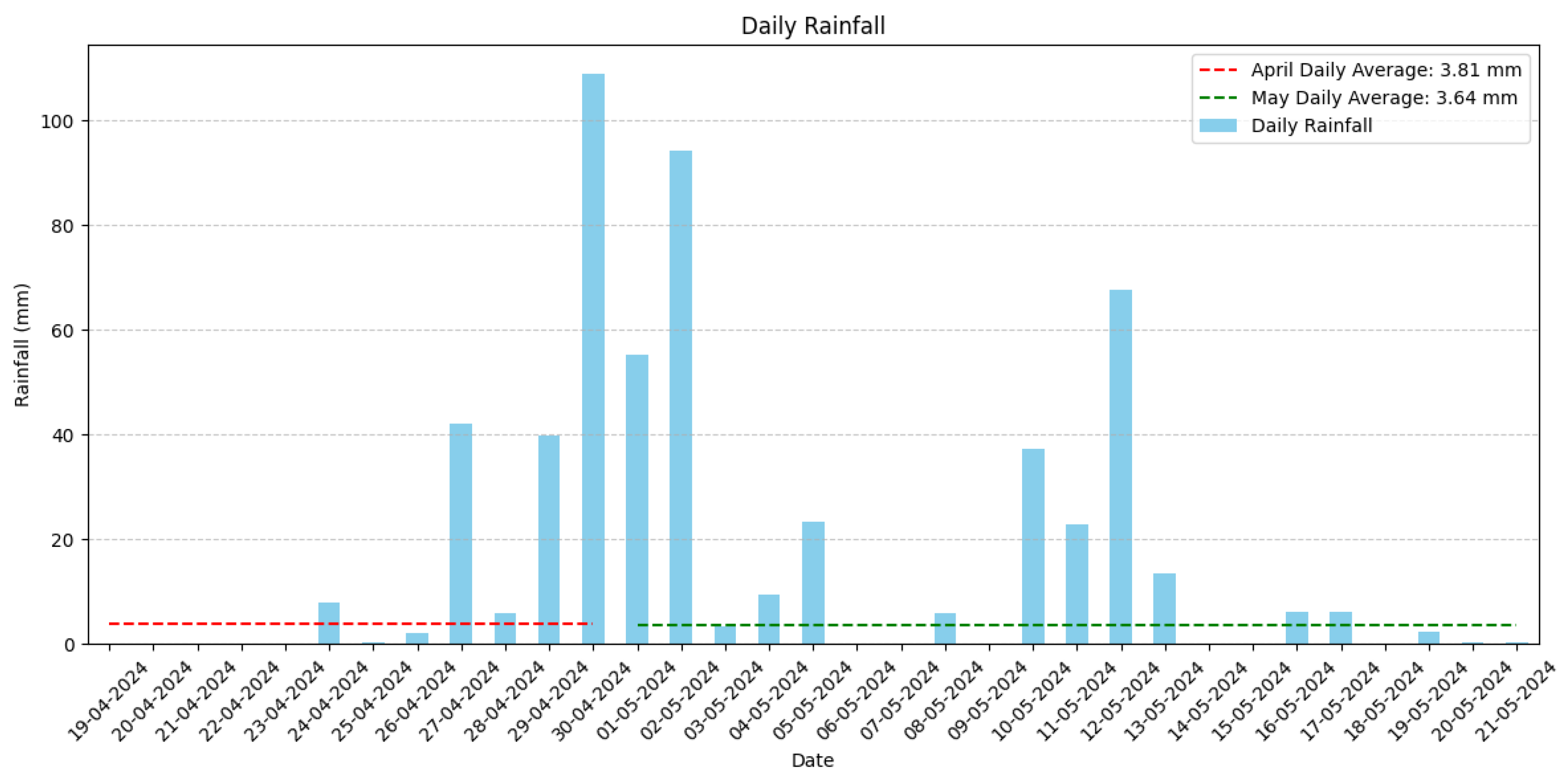
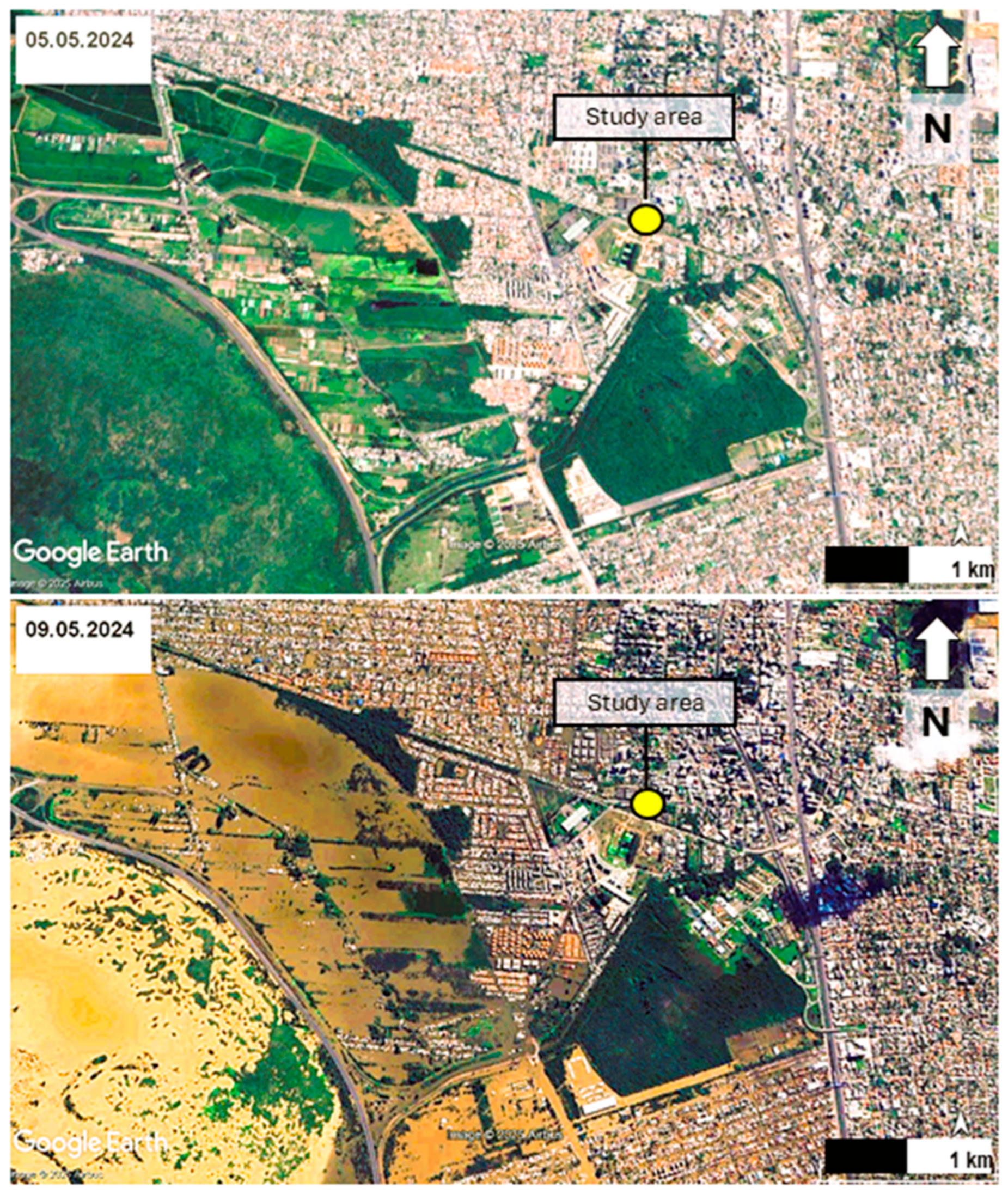
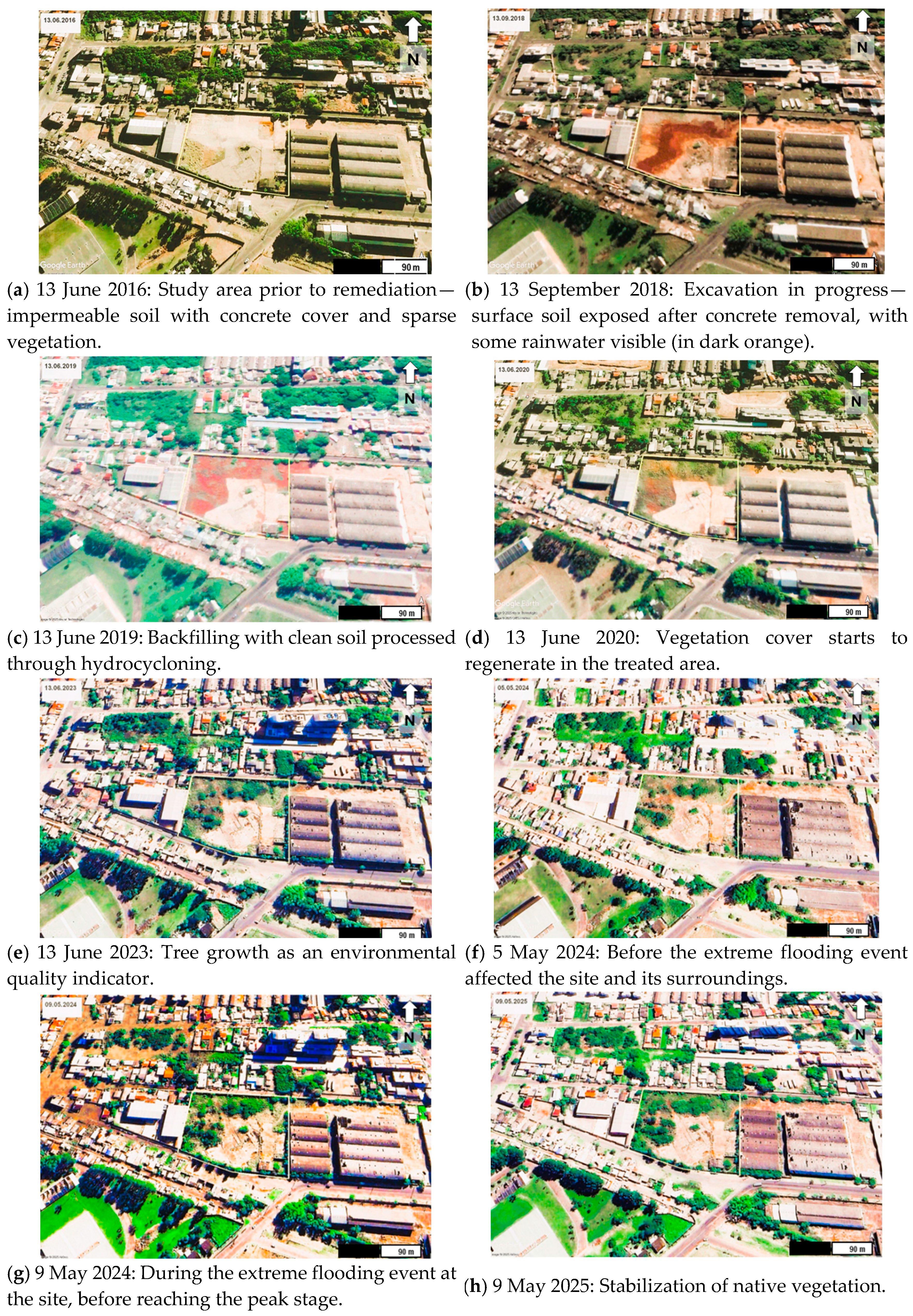
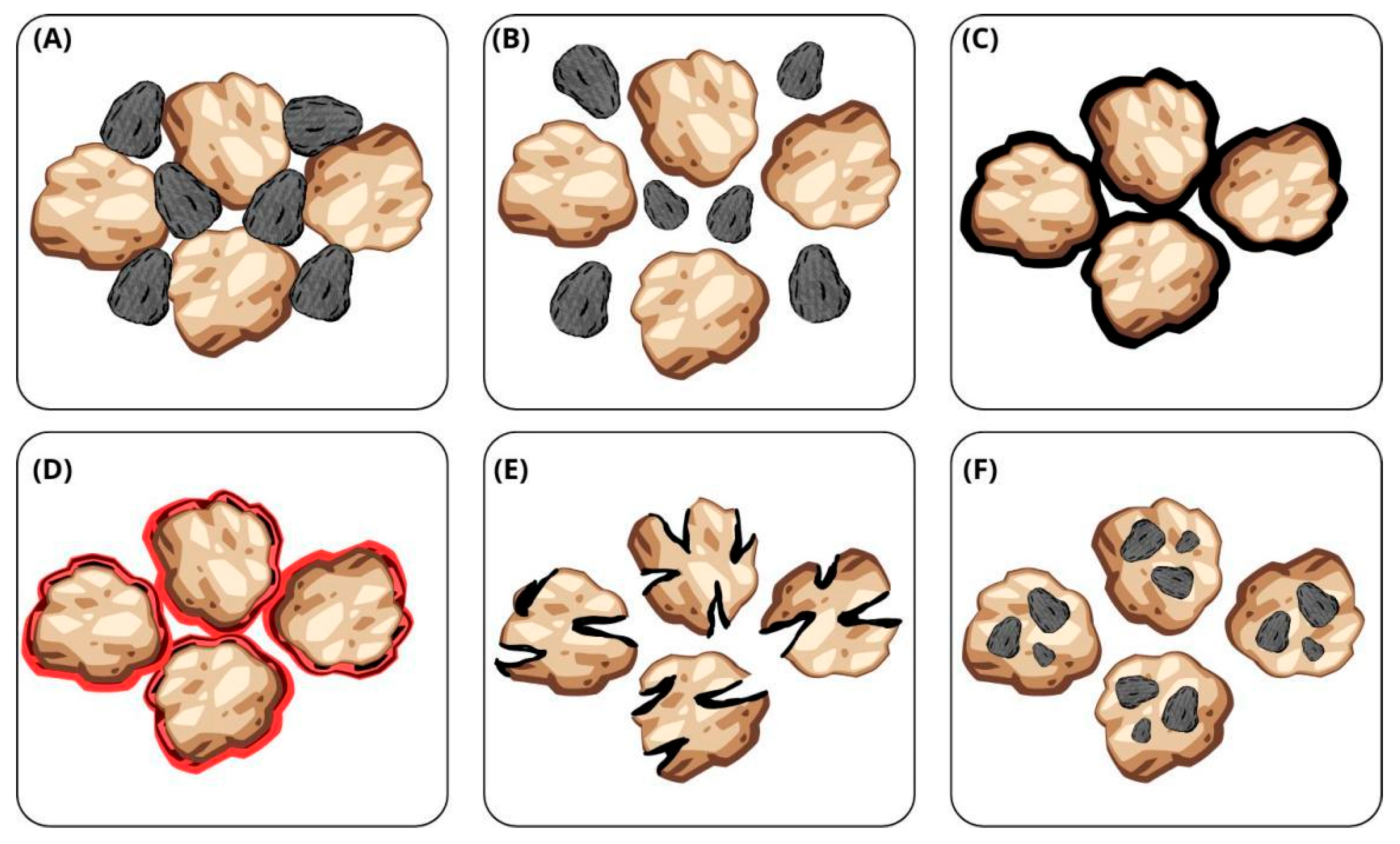

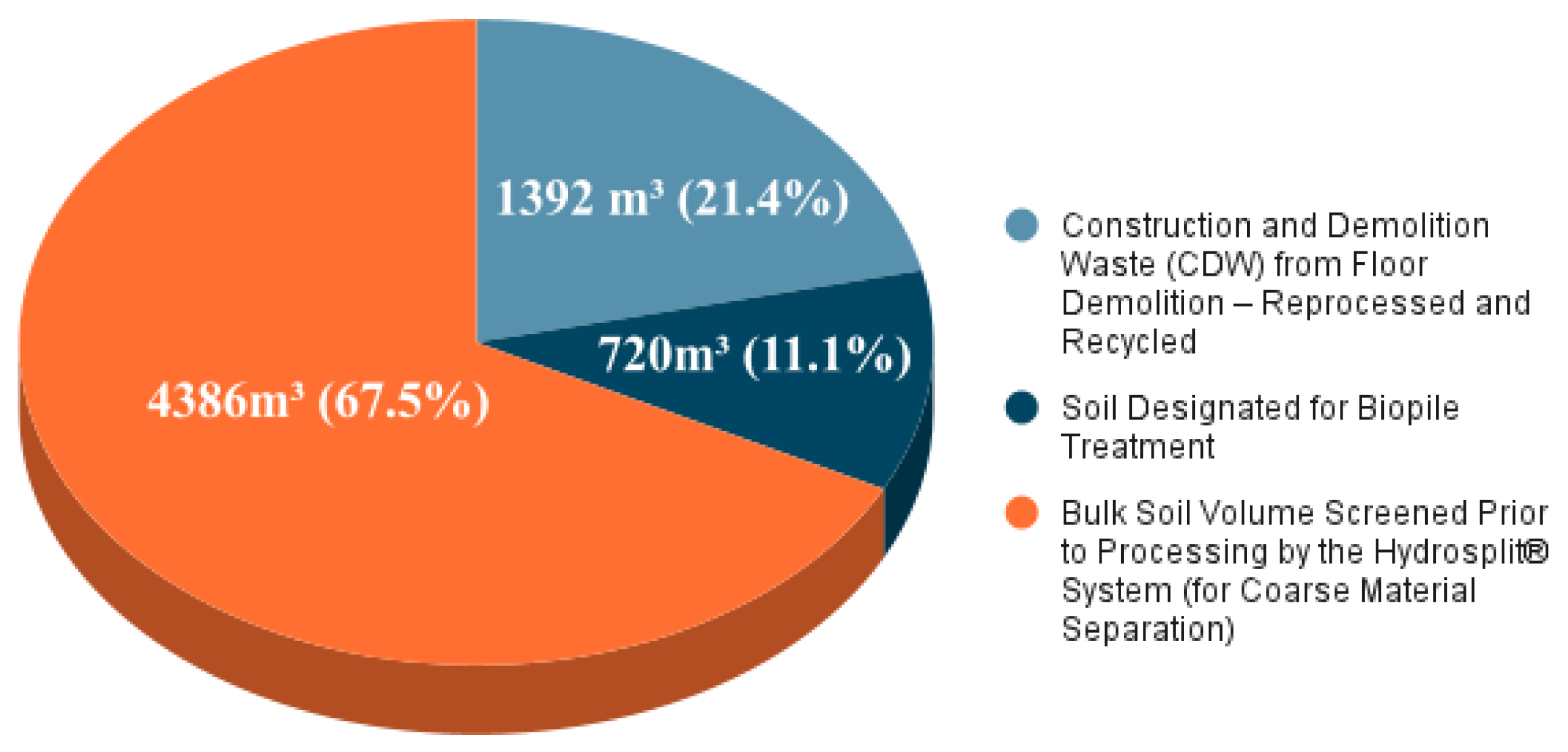
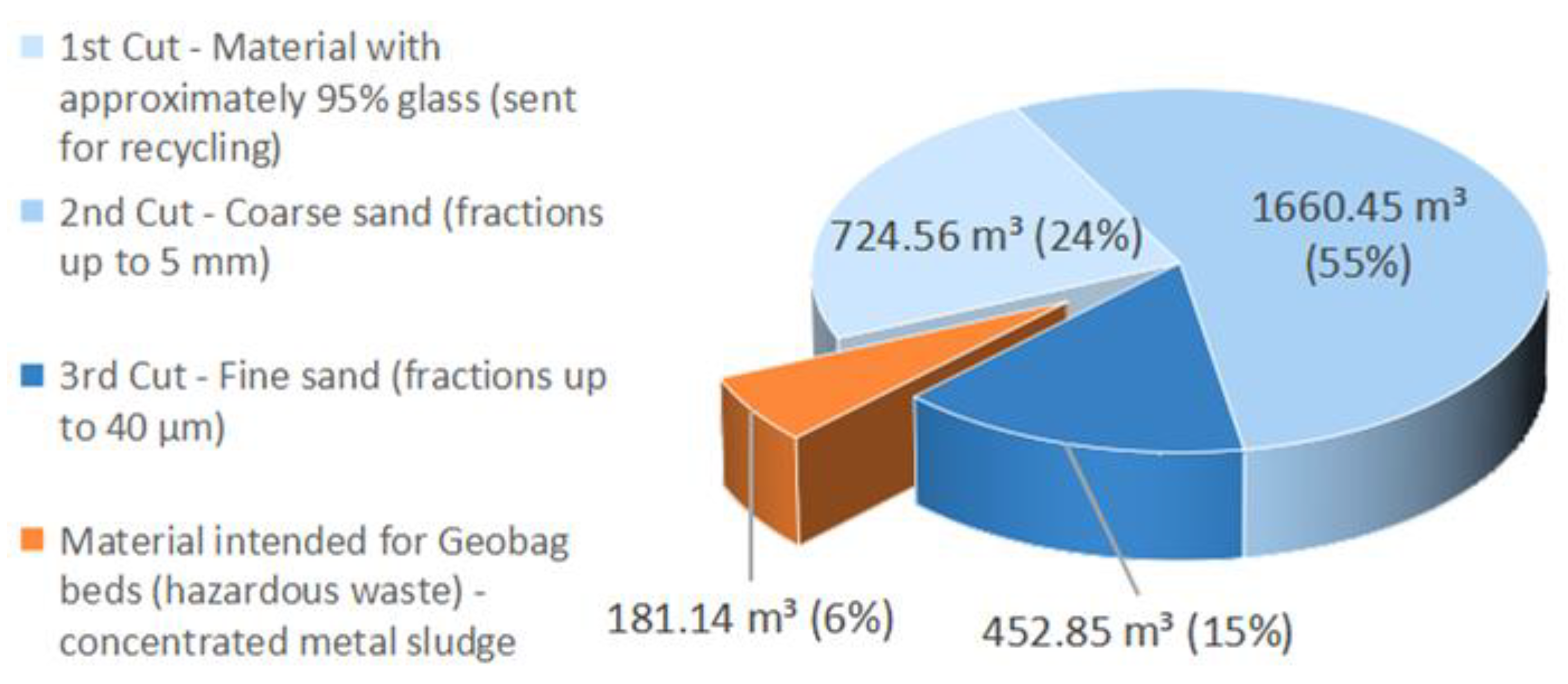
| Parameter | Unit | Raw Material (ISM) | CONAMA 420/2009 | |
|---|---|---|---|---|
| Sample 1 | Sample 2 | SSTL | ||
| Antimony | mg·kg−1 | 43 | 22 | 10 |
| Arsenic | mg·kg−1 | 120 | 230 | 55 |
| Barium | mg·kg−1 | 76 | 140 | 500 |
| Cadmium | mg·kg−1 | 16 | 17 | 8 |
| Lead | mg·kg−1 | 461 | 396 | 300 |
| Cobalt | mg·kg−1 | 13 | 12 | 65 |
| Cooper | mg·kg−1 | 90 | 69 | 400 |
| Chromium | mg·kg−1 | 65 | 83 | 300 |
| Chromium VI | mg·kg−1 | <1 | <1 | - |
| Mercury | mg·kg−1 | 4 | 2 | 36 |
| Molybdenum | mg·kg−1 | 2 | 2 | 100 |
| Nickel | mg·kg−1 | 20 | 19 | 100 |
| Silver | mg·kg−1 | 17 | 14 | 50 |
| Selenium | mg·kg−1 | 3 | <1 | - |
| Zinc | mg·kg−1 | 244 | 151 | 1000 |
| Technique | Treated Metals? | Remediation Time | Waste Generation | Relative Cost | Soil Reuse | Technical Complexity | Environmental Impact | Sustainable | Reference |
|---|---|---|---|---|---|---|---|---|---|
| Soil washing | Yes | Short | Medium | Medium–High | Yes | Medium | Low | Yes | [11] |
| Natural attenuation | Yes | Very Long | Minimal | Low | Yes | Low | Low | Yes | [2] |
| Bioremediation | No | Long | Low | Low | Yes | Medium | Low | Yes | [2] |
| Land farming (Soil Biotreatment) | No | Long | Medium | Low | Partial | Medium | Medium | Partially | [2] |
| Dig and dump | Yes | Short | High | High | No | Low | High | No | [4] |
| Soil/Residue encapsulation | Yes | Short | Does not treat, only isolates | Medium–High | No | Medium | High | No | [12] |
| Excavation | Yes | Short | High | High | No | Low | High | No | [39] |
| Incineration | No | Short | High | Very High | No | High | Very High | No | [40] |
| Parameter | Unit | Coarse Sand (ISM) | Fine Sand (ISM) | Geobag 1 | Geobag 2 | CONAMA 420 | ||
|---|---|---|---|---|---|---|---|---|
| Batch 1 | Batch 2 | Batch 1 | Batch 2 | Batch 1 | Batch 2 | SSTL | ||
| Antimony | mg·kg−1 | <1 | <1 | <1 | <1 | 78 | 65 | 10 |
| Arsenic | mg·kg−1 | <1 | <1 | 5 | 7 | 356 | 435 | 55 |
| Barium | mg·kg−1 | 42 | 14 | 16 | 26 | 309 | 350 | 500 |
| Cadmium | mg·kg−1 | 3 | 5 | 6 | 6 | 63 | 73 | 8 |
| Lead | mg·kg−1 | 46 | 58 | 133 | 160 | 2270 | 2460 | 300 |
| Cobalt | mg·kg−1 | 1 | <1 | <1 | 2 | 103 | 89 | 65 |
| Cooper | mg·kg−1 | 13 | 20 | 20 | 34 | 450 | 520 | 400 |
| Chromium | mg·kg−1 | 123 | 104 | 88 | 72 | 131 | 128 | 300 |
| Chromium VI | mg·kg−1 | <1 | <1 | <1 | <1 | 131 | 645 | - |
| Mercury | mg·kg−1 | 139 | 979 | 101 | 174 | 10 | 14 | 36 |
| Molybdenum | mg·kg−1 | 5 | 4 | 4 | 3 | 4 | 4 | 100 |
| Nickel | mg·kg−1 | 32 | 26 | 24 | 24 | 55 | 63 | 100 |
| Silver | mg·kg−1 | 6 | <1 | <1 | <1 | 109 | 116 | 50 |
| Selenium | mg·kg−1 | <1 | <1 | <1 | <1 | 32 | 17 | - |
| Zinc | mg·kg−1 | 114 | 112 | 30 | 50 | 770 | 844 | 1000 |
Disclaimer/Publisher’s Note: The statements, opinions and data contained in all publications are solely those of the individual author(s) and contributor(s) and not of MDPI and/or the editor(s). MDPI and/or the editor(s) disclaim responsibility for any injury to people or property resulting from any ideas, methods, instructions or products referred to in the content. |
© 2025 by the authors. Licensee MDPI, Basel, Switzerland. This article is an open access article distributed under the terms and conditions of the Creative Commons Attribution (CC BY) license (https://creativecommons.org/licenses/by/4.0/).
Share and Cite
Sillos, M.; da Silva, P.F.; Suhogusoff, A.; Brito, G. Climate-Resilient and Sustainable Soil Remediation: Hydrocycloning for Metal Removal in Flood-Prone Brazilian Region. Sustainability 2025, 17, 9083. https://doi.org/10.3390/su17209083
Sillos M, da Silva PF, Suhogusoff A, Brito G. Climate-Resilient and Sustainable Soil Remediation: Hydrocycloning for Metal Removal in Flood-Prone Brazilian Region. Sustainability. 2025; 17(20):9083. https://doi.org/10.3390/su17209083
Chicago/Turabian StyleSillos, Marcos, Paula F. da Silva, Alexandra Suhogusoff, and Graça Brito. 2025. "Climate-Resilient and Sustainable Soil Remediation: Hydrocycloning for Metal Removal in Flood-Prone Brazilian Region" Sustainability 17, no. 20: 9083. https://doi.org/10.3390/su17209083
APA StyleSillos, M., da Silva, P. F., Suhogusoff, A., & Brito, G. (2025). Climate-Resilient and Sustainable Soil Remediation: Hydrocycloning for Metal Removal in Flood-Prone Brazilian Region. Sustainability, 17(20), 9083. https://doi.org/10.3390/su17209083






